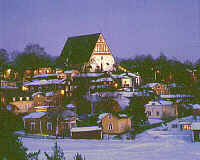|
| |
In order to survive, a linguistic minority must help to safeguard its
own position through its own activity. Swedish-speakers in Finland may have had a better
starting point for doing this than most other minorities, as they were far from being an
oppressed or peripheral population group when Finland was shaped into a nation and an
independent country.
The national awakening of Swedish-speaking Finns at the end of the
19th century created a number of cultural institutions which still have great vitality. A
Swedish-language political party was also founded, which took the name the Swedish
People's Party in 1906. This non-socialist party has since attracted 70-80% of all
Swedish-speaking voters in general elections. The Swedish People's Party has also been
represented in most governments since 1917, when Finland became an independent republic.
The party has been more influential than its size suggests and has successfully protected
the interests of the Swedish-speaking population. At present (1997), it has 11 of the 200
seats in the Finnish
Parliament. There are two representatives of the party in the coalition Government
appointed in 1995. The dominant political parties in Finland - the Social Democratic
Party, the conservative National Coalition Party, the Centre Party, the Left-Wing Alliance
(the 'follower' of the Communist Party) and the environmentalist Green League - are
bilingual and also have operations in Swedish.
Many monolingual Swedish-language institutions and organizations
were set up amid efforts towards greater solidarity resulting from Finnish independence. A
Swedish-language university, Åbo Akademi,
was founded in 1918, and in 1923, the diocese of Borgå was set up for the
Swedish-language parishes in the Evangelical-Lutheran Church, to which 85% of the
population belong. Swedish-language military units in the Finnish army were also
established. Today, one of the brigades of the Finnish Defence Forces is totally
Swedish-speaking, and most young Swedish-speakers do their obligatory military service
with the Nyland Brigade in Ekenäs.
|
|

Borgå (Porvoo) Cathedral
|
|
In 1919, the
Swedish Assembly of Finland was founded to watch over the standing of Swedish when the
constitution for the independent republic of Finland was being drafted. The Assembly,
which represents a cross-section of political opinion, including representatives of the
Swedish People's Party, the Social Democratic Party and the Left-Wing Alliance, has
functioned since then as a pressure group for protecting the interests of
Swedish-speakers. The Assembly now receives financial support from the
Government.Swedish-speaking Finland also has a lively cultural life, including four
permanent theatres with local authority support; of these, the Swedish Theatre in Helsinki is designated
'Finland's national Swedish-language theatre'. The other theatres receiving municipal
support are Åbo Swedish Theatre, Vasa Theatre and the Lilla Teatern in Helsinki. There
are also a dozen Swedish-language newspapers in Finland, notably Hufvudstadsbladet (published in Helsinki, circulation
59,000), Vasabladet (27,000), Jakobstads Tidning (12,000), Västra Nyland
(Ekenäs, 11,000), Åland (11,000), Borgåbladet
(9,000) and Finland's oldest newspaper, Åbo Underrättelser, with a current
circulation of 7,000.
|
The Moomintroll is probably one of the most typically Swedish-speaking Finnish things
there is, but he is well known all over the world. Tove Jansson, who created the Moomins,
is a lady of many talents, however: she made her debut as a painter back in the 1940s and
is also an acclaimed writer, whose books appeal to both children and adults.
The Finnish Broadcasting
Company maintains two Swedish-language channels, renamed Radio Vega and Radio Extrem
as of October 1, 1997, with the former broadcasting national and regional programming and
the latter aiming at a young audience. Swedish-language television broadcasts by Finlands
Svenska Television claim about one tenth of the total national broadcasting time, and
there are also some private bilingual or Swedish local transmitters. Several hundred books
are published in Swedish in Finland every year, the leading Swedish-language publishing
houses being Söderströms and Schildts. There are also numerous magazines in
Swedish. |
|

Tove Jansson |
It is thus possible to live your entire life in Swedish in Finland, although there
is considerable contact between the two linguistic groups and intermarriage is common. The
prospects for Swedish in Finland look promising, mainly thanks to Swedish-speakers'
energetic work to preserve their cultural heritage and the majority's positive attitude to
this aspiration. The fact that Swedish-speakers have their own school system, with
teaching in their own language, is the best guarantee of the continued existence of
Swedish in Finland
|